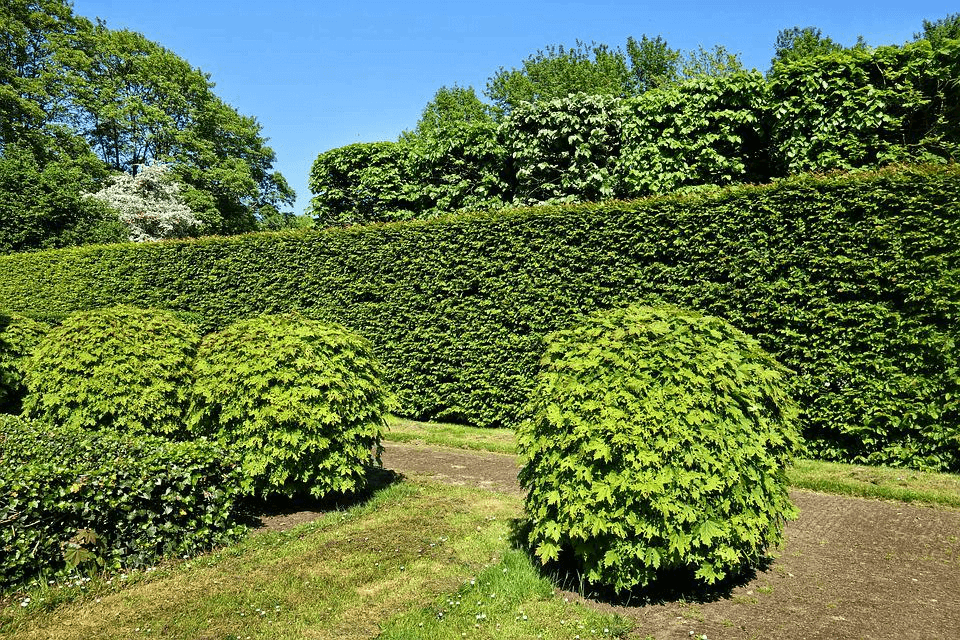To achieve an attractive hedge, it’s crucial to trim it at the appropriate time. Timely trimming promotes even growth, enhancing its visual appeal. So, when should you trim your hedge to ensure it looks its best?
The best time to trim a hedge is during winter. They may have developed buds, but they are dormant at the time. When they start growing again, they will grow as trimmed. You can also trim at the end of a growth period to maintain their height, shape, and appearance.
Trimming hedges ensures that they stay healthy and appealing.

What we cover
ToggleWhen is the best time to trim a hedge?
It depends on where you live and the climatic conditions of your area. However, the best time to trim a hedge is when it is dormant and has little growth. For most plants, winter is the dormancy period.
The hedge may have developed buds that are waiting for summer or spring to open up into flowers. Cut the branches and shape the hedge as desired when it is dormant. Once it starts growing, it will grow into the shape and size you cut it.
Additionally, early spring, just before birds start nesting on the hedges is a good time to trim hedges.
Do not trim hedges in summer.
Further, start trimming hedges in their second year of growth. Trim your hedge annually or more times depending on its growth rate.
How to trim hedges
Trim by hand
Depending on the size of the hedge, it is best to trim it by hand. You can use shears or pruning scissors to trim your hedge perfectly and accurately.
When you trim your hedge by hand, you can see the condition of the hedge. You can see the overgrown branches and the parts of the hedge that need more sunlight.
If your hedge is too long or large to trim by hand, you can use an electric hedge trimmer. It is fast and makes it easy to prune over a large area.
Prune during winter
Trimming your hedge in winter is best as plants are usually dormant during this period and will not have produced buds. Pruning in winter also helps the plant grow back stronger and flourish because of the new bud growth.
If you cut the buds, the hedge will take longer to recover and fill out because you will have eliminated the plant’s energy system.
Ideal hedge shapes
When you trim your hedges, make them narrower at the top and wider at the bottom. When the top is wider, there will be little light getting to the bottom of the hedge. Poor sunlight causes poor growth and weakness in the hedge.
To achieve the ideal hedge shape, start trimming your hedge from the bottom upwards. Make sure to stop and check your progress after every few cuts. It ensures that you get the intended shape of the hedge. It is difficult to rectify a trimming mistake.
Benefits of trimming a hedge
- It ensures that sufficient sunlight reaches all parts of the hedge for proper growth.
- It shapes the hedge
- Maintains its appeal and the look of the yard.
- Maintain it at the preferred size and height. It controls the volume of the hedge.
- It removes dead and diseased branches and eliminates the spread of infections to nearby plants.
- Makes it stronger and bushier.
- Shortens the hedges to provide a clear view of the garden.
Tips for a proper hedge trim
- Ensure that your pruning scissors are sharp and clean.
- Decide on the width of the hedge when planting.
- Hand-held pruners enhance the accuracy of the trim.
- Choose evergreen plants to make your hedge.
- Make a hedge with plants that can attract birds. Also, ensure that birds are not nesting when you trim.
- Use a hedge clipping guide to trim your hedges. It ensures that you maintain straight cuts and the correct height for the hedge.
- Do not trim evergreen hedges when they are dry. Always ensure they have sufficient moisture in and around them before trimming.
Types of hedges you can plant
Evergreen hedges
As the name suggests, evergreen hedges are always green. They do not shed their leaves while others do especially during summer.
Since they are always green, they do not have a specific time to prune. The best time to prune is during winter when growth is dormant.
However, if you choose to trim them in summer, water them a day or two before. Trimming them when dry may cause them to lose stored moisture and die. Light trimming is recommended when you don’t do it in winter.
Deciduous hedges
How often should hedges be trimmed?
Trim your hedges annually during winter. It ensures that your hedge can grow properly and maintain the appeal of your yard.
Overgrown shrubs and trees around your home can pose a danger to people and property. Strong rains can cause trees to fall on your house or cars. It will be expensive to repair the damage caused. Therefore, trimming hedges, trees, and shrubs around your home is essential.
How often you should trim your hedges depends on:
- The type of plants you use for hedges
- Your preferences and needs
- Sunshine and rainfall availability
- Time of year
If you cannot trim your hedge, you can hire professionals to do it for you.
Unlike evergreen hedges, deciduous hedges shed their leaves in autumn. Prune deciduous hedges at the beginning of spring just before their buds pop open.
You may also have to trim them towards the end of summer after a growth spurt. It helps to maintain their height, and width and enhance proper growth.

Benefits of hiring professionals to trim your hedge
They have professional trimming tools
You cannot use the wrong tools to trim your hedges and expect the right results. Professionals have all the tools needed to trim hedges, bushes, and small trees in your compound.
Safety
While trimming hedges is an easy task, accidents are likely to happen if you are not handy. You can cut yourself with the scissors or sharp edges on the hedge. Hiring a professional to carry out the work for you eliminates the risk of danger. Besides, they carry insurance that covers their bills in case of an accident.
Proper trimming
When trimming a hedge, you have many expectations. If all you have is tools and the time to trim, you may not meet your expectations.
However, when you hire a professional, they will listen to your needs and use their knowledge and experience to meet them. They will cut and shape your hedges as you described them to them.
Enhances the visual appeal of your lawn
Hiring a professional to trim your hedge enhances the appearance of your lawn or garden. A perfectly trimmed hedge makes the lawn attractive.
If you’re selling your home, aesthetics determine how much and how fast you can sell it.
Time saving
Hiring a professional tree service to trim your hedges allows you the time to do other things. Depending on the size of your garden, it may take up to several hours to finish trimming. You can use this time to engage in other activities with the confidence that your hedges are competently trimmed.
Additional services
Professionals are likely to offer additional services such as cleaning up after trimming. You do not have to worry about how to dispose of the leaves and branches trimmed off your hedges.
How much does hedge trimming cost?
If you hire a professional tree service to trim your hedges, you will pay $50 to $80 per hour. How much you pay depends on the complexity of the job. If the hedges are overgrown you will pay more. On average, most people pay $65 per hour for professional hedge trimming.
Hire a professional to trim your hedges
Gotreequotes.com is a free tool to hire professional tree service providers.
It connects homeowners to professionals in the following easy steps.
- Enter your zip code at the top of the tool.
- Fill in the form to provide more details about the tree service you need.
- You will receive three or four quotes and advice from professional and licensed tree removal service providers.
- Hire one in your budget.















